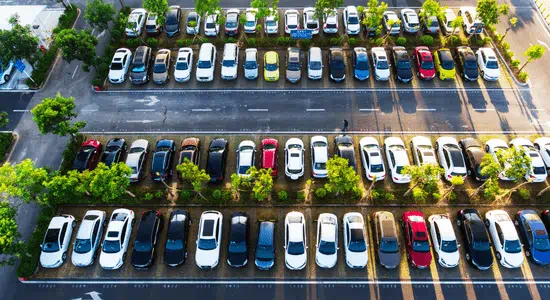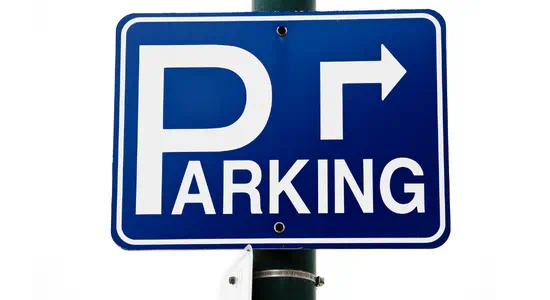Many journeys begin and end with a parking space and car parks are a ubiquitous part of our urban landscapes. Each parking space ranges in area from 15-30 sq mt and it’s estimated that a driver needs anywhere from 2 to 5 parking spaces every day. This is no small feat, which begs the question, what role does parking have in shaping city planning?
city mobility and planning
In the last few decades, we have seen a growing number of European cities making major changes in their approach to parking policies in urban settings. People are tired of having public spaces taken up for more and more cars, with no end in sight. Despite the construction of new car parks and roads, traffic congestion has only increased. Parking has emerged as one of the key aspects of city planning that affects how people navigate cities and their relationship with public spaces.

Parking garages consume a lot of land while not giving back much in terms of multifunctionality or aesthetics. The construction of too many car parks is a flaw in city planning that contributes to dispersed development and can increase travel distance. Therefore, the planning, design, and management of car parks are vital for any smart city that wants to improve livability and walkability within the city.
The solution, however, is not building more parking spaces. Construction of additional parking services can increase driving and inadvertently increase the demand for parking. The way through this conundrum is to first focus on managing the existing supply of parking spaces. Managing and optimising the use of existing car parks is a more cost-effective strategy to reduce parking demand while providing an exciting business opportunity for underutilised parking garages. Smart parking platforms, like Mobypark, are at the forefront of helping cities manage their parking supply and demand. A smart parking platform can help business owners with extra parking rent their space to customers, without much hassle. Smart solutions are the biggest driver for change in parking policies and can help bridge the supply and demand gap many cities face.
City planning policies also need to change if we want to avoid building more parking garages. Many cities have antiquated parking planning rules that specify a minimum number of parking spaces, especially for residential developments. Many cities require 2 parking spots per unit, but this varies. As we move towards more shared mobility and transit-based city planning, these rules only serve to drive up the cost of the construction and make it more expensive to live there. Again, smart parking technology can step in here to help people rent out unused parking spaces.
the evolution of parking planning

The older paradigm of parking planning was focused heavily on personal vehicle use but in most modern cities, travel is multimodal. This has created a need for parking planning to evolve to a new model that better reflects our current concerns around land use, quality of life, and sustainability in city design.
The new paradigm of parking planning takes a more holistic approach. We can’t simply keep constructing more and more car parks and a holistic approach looks at the spectrum of parking problems, from supply-demand imbalances to underutilisation of existing parking spaces. This new approach to city planning considers sharing of parking facilities, smart solutions for management and pricing, more efficient and effective regulations, and promotion of public transport and other alternative modes of travelling.
differences in parking in european cities
Amsterdam
The Dutch government follows the most rigid EU regulations concerning air quality. 40% of air pollution in Amsterdam is caused by 10% of cars, and the city has responded strongly by working towards dismantling car-centric policies. Paid parking can be found in almost every part of the city which has contributed to a 20% reduction in traffic congestion in the inner city.
The central city poses some interesting challenges for drivers. If they want to park, there are three options: apply for a permit, buy a parking space, or rent space in a car park. Parking permits vary in price depending on the area. It can be as high as €270 per permit or even higher and the waitlist can take months, if not years. Buying a parking space is quite expensive as well. Renting a parking space is the best option for many. Amsterdam, like the rest of the Netherlands, has been reclaiming public spaces from cars for over 40 years now. Converting dreary, polluted, and cramped roadways into play streets for children, pedestrians, and cyclists have revitalised many public spaces for the better.
Paris
Before the mid-1990s, Paris followed a fairly pro-car policy and relaxed parking regulations. However, as we hurtled towards the new millennium, city planning and parking policies began to evolve.
Since 2003, Paris has reduced on-street parking while turning free parking into paid spaces. This has helped the city reduce dependence on private car ownership while strengthening public infrastructure. Since then, many parking spaces have been converted into bicycle parking, disabled parking, and tramway access lanes. At the end of 2020, it was announced that Paris would be removing 70,000 surface parking spots to create more space in crowded and narrow streets. And what do they plan on doing with this new space? That’s up to the citizens to decide but the focus is on increasing greenery and improving the quality of public spaces.
In 2021, further initiatives were announced to update parking spaces to make them more sustainable, inclusive, and accessible. These initiatives include over 1000 new parking spaces for people with reduced mobility, parking spots for ride-sharing services, new charging stations for EVs both on-street and underground, and plans for bicycle parking. The overarching goals are to promote low-emission transportation, improve accessibility in public spaces, and support shared mobility options.
Copenhagen
Parking policy goals in this Danish city focus on promoting alternatives to car ownership, reclamation of public spaces, and reducing carbon emissions.Copenhagen has steep parking rates, particularly in the city centre, which encourages travellers and commuters to use alternative transport like public transit or cycling. They have also steadily reduced on-street parking spaces in favour of bike lanes and new pedestrian areas. Reclamation of public spaces and changes in city planning began in the 1970s. Strøget, in the city centre, has long been pedestrianised while many districts like Nørrebro are being redesigned with more shared public spaces and less parking.
Antwerp
Antwerp, Belgium manages parking through a private-public partnership with Gemeentelijk
Autonoom Parkeerbedrijf Antwerpen (GAPA), also called Municipal Autonomous Parking Antwerp.
GAPA has emphasised paid parking, regulatory enforcement, and the use of smart parking solutions in their parking policies. GAPA works hard to promote shared parking, offering services to make it easier for people to switch to shared parking. This includes an online platform to facilitate leasing and rental of parking spaces, bringing private parking lots into public use, and subsidising new car parks.
Berlin
In the 1990s, Berlin abolished parking minimums (except for disability parking and bicycles) and does not impose maximums. Deregulation of off-street parking has helped the city narrow down on on-street parking and improve its management over the last 20 years. Removal of parking minimums in developments was met with no backlash, perhaps due to declining car ownership rates and improved public transportation. However, on-street parking management remains an issue in many areas of the city and smart management tools may be the key to solving this.
Brussels
Brussels’ parking policy focuses on decongestion and promoting alternative modes of transport. The Good Move Regional Mobility Plan was launched in 2020 to achieve these goals and promote sustainable mobility in the region. The plan aims to improve the quality of life across neighbourhoods in Brussels by influencing the travel habits of residents to create a "closer city" where walking and cycling are encouraged.
According to this plan, priority is given to off-street parking, price modulation for different sectors, reducing the number of parking spaces in public areas, and encouraging the use of hybrid vehicles, electric vehicles, and new mobility solutions.
what is the impact of parking solutions in the city?
Innovative approaches to parking policy within city planning have the potential to improve the social, environmental, and economic quality of modern cities. The most impactful parking solutions are those that synergise with the city’s goals: this can be reducing carbon emissions, lowering traffic congestion, decreasing dependence on private cars, or improving the quality of life for their residents and tourists.
.png?h=300&iar=0&w=550&rev=13148cc683524e6cba690b07fb5daa45&extension=,webp&hash=86E602B08E03EAF116F870527C7193C0)
The solutions we have seen in cities across Europe have shown us that we don’t need to expand the supply of parking spaces, but rather, we need to reassess what we want from our urban spaces and use smart solutions and efficient regulations to meet these goals. Good parking management is essential for any smart city and considering parking solutions through the lens of shared parking. Shared spaces are a cost-effective, convenient solution for many parking issues plaguing modern European cities. Rethinking these ‘empty’ spaces through shared use can help European cities innovate even bolder solutions in city planning.
Read more about parking
HOW TO INCREASE THE RETURNS AND LOWER THE COSTS OF PRIVATE PARKING GARAGES
URBAN MOBILITY DEVELOPMENTS: PAST AND FUTURE
SMART KERB MANAGEMENT
Share your story
Do you have an innovation, research results or an other interesting topic you would like to share with the professionals in the infrastructure, traffic management, safety, smart mobility and parking industry? The Intertraffic website and social media channels are a great platform to showcase your stories!
Please contact our Sr Brand Marketing Manager Carola Jansen-Young.
Are you an Intertraffic exhibitor?
Make sure you add your latest press releases to your Company Profile in the Exhibitor Portal for free exposure.





